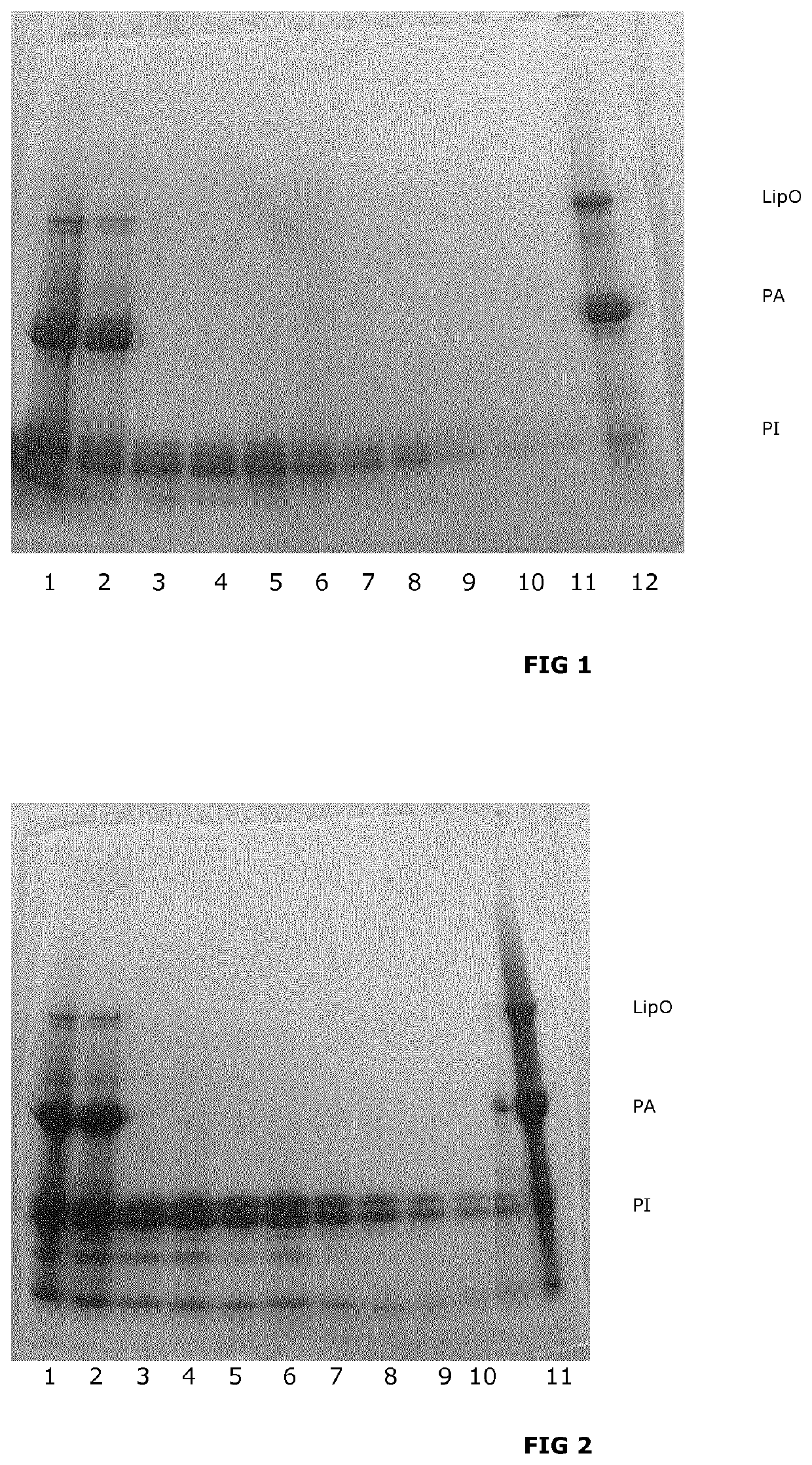Integrated precipitation and membrane filtration processes for isolation of potato proteins
a technology which is applied in the field of integrated precipitation and membrane filtration methods, can solve the problems of low flux rate, general non-industrial use of membrane filtration, and detriment to product yield, and achieve the effect of high flux rate and without loss of produ
- Summary
- Abstract
- Description
- Claims
- Application Information
AI Technical Summary
Benefits of technology
Problems solved by technology
Method used
Image
Examples
example 1
PA and PI in Separate Fractions from Potato Juice Using Alginate and Microfiltration at pH 3
[0265]3800 ml potato juice, test solution 1 (True protein content 10 g / L) is heated to 50° C. and then centrifuged for three minutes at 1430 G, the supernatant is collected (test solution 2). 76 ml of 1.5 wt % alginate solution is added to test solution 2 and pH is adjusted to pH 3 with 10% sulphuric acid. The solution is then incubated with mixing at 30° C. for 5 minutes.
[0266]After incubation the solution is loaded onto a microfiltration unit with a 0.65 μm hollow fiber membrane. Cross flow is 2 L / min. During the initial concentration the permeate is collected in fractions of 500 ml (test solutions 3 through 9). When 250 ml retentate is remaining, pH in the retentate is adjusted to pH 0.9 with hydrochloric acid. 250 ml of water adjusted to pH 1.3 with hydrochloric acid is added to the retentate for washing of the retentate (diafiltration). 250 ml of permeate is then collected (test solution...
example 2
PA and PI in Separate Fractions from Potato Juice Using Microfiltration at pH 2.7
[0292]1600 ml potato juice, (test solution 1) is added calcium chloride to a final concentration of 20 mM and di-Sodium-hydrogen-phosphate to a final concentration of 10 mM, pH is adjusted to 7.5 with 1 M NaOH (test solution 2). Test solution 2 is incubated for 5 min, whereafter fibers and other insoluble material is removed by centrifugation (3 min at 1430 G). The supernatant is collected as test solution 3. Test solution 3 is adjusted to pH 2.7 with 10% sulfuric acid. Test solution 3 is loaded onto a microfiltration unit with a 0.2 μm hollow fiber membrane. Cross flow is 1.2 L / min. During the initial concentration the permeate is collected in fractions of 466 ml (test solutions 4 through 6). When 200 ml retentate is remaining, 200 ml of 0.1 M NaCl is added to wash the retentate (dialfiltration). 200 ml of permeate is then collected (test solution 7). This procedure is performed four more times resulti...
example 3
PA and PI in One Fraction from Potato Juice Using Ultrafiltration at pH 3
[0316]1600 ml potato juice, test solution 1 (True protein content 10 g / L) is added calcium chloride to a final concentration of 20 mM and di-Sodium-hydrogen-phosphate to a final concentration of 10 mM, pH is adjusted to pH 6.8 with 1 M NaOH (test solution 2). Test solution 2 is incubated for 5 min, where after fibers and other insoluble material is removed by centrifugation (3 min at 1430 G). The supernatant is collected as test solution 3. Test solution 3 is adjusted to pH 2.9 with 10% sulphuric acid and mixed at room temperature for 10 minutes. After incubation the solution is loaded onto an ultrafiltration unit with a 10 kD (10.000 D) hollow fiber membrane. Cross flow is 1.2 L / min. When 200 ml retentate is remaining, pH in the retentate is adjusted to pH 1.5 with sulfuric acid. 200 ml of water adjusted to pH 1.5 with sulfuric acid is added to the retentate for washing of the retentate (diafiltration). 200 ml...
PUM
| Property | Measurement | Unit |
|---|---|---|
| pH | aaaaa | aaaaa |
| pH | aaaaa | aaaaa |
| pH | aaaaa | aaaaa |
Abstract
Description
Claims
Application Information
 Login to View More
Login to View More - R&D
- Intellectual Property
- Life Sciences
- Materials
- Tech Scout
- Unparalleled Data Quality
- Higher Quality Content
- 60% Fewer Hallucinations
Browse by: Latest US Patents, China's latest patents, Technical Efficacy Thesaurus, Application Domain, Technology Topic, Popular Technical Reports.
© 2025 PatSnap. All rights reserved.Legal|Privacy policy|Modern Slavery Act Transparency Statement|Sitemap|About US| Contact US: help@patsnap.com

